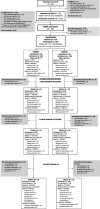Maintenance effects of a multilevel workplace intervention to reduce sedentary time: twenty-four-month follow-up of the group randomized clinical trial 'Stand and Move at Work'
- PMID: 40197229
- PMCID: PMC11978190
- DOI: 10.1186/s12966-025-01731-w
Maintenance effects of a multilevel workplace intervention to reduce sedentary time: twenty-four-month follow-up of the group randomized clinical trial 'Stand and Move at Work'
Erratum in
-
Correction: Maintenance effects of a multilevel workplace intervention to reduce sedentary time: twenty-four-month follow-up of the group randomized clinical trial 'stand and move at work'.Int J Behav Nutr Phys Act. 2025 Jun 2;22(1):67. doi: 10.1186/s12966-025-01770-3. Int J Behav Nutr Phys Act. 2025. PMID: 40457461 Free PMC article. No abstract available.
Abstract
Background: The long-term impact of multilevel workplace sedentary behavior interventions has not been established beyond 12-months. We conducted a 2-arm group randomized trial examining the 24-month efficacy of a multilevel workplace intervention with sit-stand workstations (SSW) relative to the same multilevel intervention with delayed SSW implementation until 12-months.
Methods: Worksites (N = 24 worksites, N = 630 employees) were randomized to participate in Stand and Move at Work and received: (a) STAND + , a 12-month multilevel behavioral intervention targeting reductions in sedentary time and increases in light physical activity (LPA) with SSW delivery during the 12-months or (b) MOVE + , the same multilevel intervention, however with SSW delivery at the end of the 12-month primary assessment period. We present maintenance endpoints (24-month follow-up) of objectively measured sedentary behavior variables as well as cardiometabolic biomarkers of the total sample and an at-risk exploratory dysglycemic (prediabetes or diabetes) subgroup per study arm.
Results: All worksites (N = 24; from academic [n = 8], industry/healthcare [n = 8], and government [n = 8] sectors) were retained and participated in 24-month follow-up data collection. A total of 464 participants (248 STAND + , 216 MOVE + ; 19 ± 6 per worksite; 45.8 ± 10.6 years of age, 73% female) completed the 24-month assessment. At 24 months, the adjusted within-arm difference in sitting was -37.3 (CI:-51.9, -22.7) min per 8 h workday for STAND + and -23.4 (-39.7, -7.0) min per 8 h workday for MOVE + . Findings at 12-months were reproduced at 24-months, in which the majority of reductions in sitting translated to increasing standing with minimal change in LPA. There were no significant changes in cardiometabolic risk within the total sample, while there were some significant changes in triglycerides and blood pressure for the dysglycemic participants.
Conclusions: Multilevel workplace interventions incorporating SSWs have the potential to sustain reductions in workplace sedentary time through 24-months. Further, delayed introduction of SSWs following a 12-month multilevel workplace intervention seem to produce similar sitting time reductions relative to immediate introduction. SSWs are a robust environmental stimulus within multilevel interventions targeting workplace sedentary behavior. A larger sample size is needed to detect concomitant impact on cardiometabolic health.
Trial registration: ClinicalTrials.gov Identifier: NCT02566317. Registered on 2 October 2015, the first participant enrolled 11 January 2016. https://clinicaltrials.gov/ct2/show/NCT02566317 . See Consort checklist.
Keywords: Maintenance; Multilevel; Sedentary behavior; Workplace.
© 2025. The Author(s).
Conflict of interest statement
Declarations. Ethics approval and consent to participate: This study was reviewed and approved by the Arizona State University (STUDY00002561) Internal Review Board on 12 May 2015. Consent was obtained from all participants prior to study participation. Consent for publication: Not applicable. Competing interests: The authors declare that they have no competing interests.
Figures
Similar articles
-
Efficacy of the 'Stand and Move at Work' multicomponent workplace intervention to reduce sedentary time and improve cardiometabolic risk: a group randomized clinical trial.Int J Behav Nutr Phys Act. 2020 Oct 27;17(1):133. doi: 10.1186/s12966-020-01033-3. Int J Behav Nutr Phys Act. 2020. PMID: 33109190 Free PMC article. Clinical Trial.
-
An intervention to reduce sitting and increase light-intensity physical activity at work: Design and rationale of the 'Stand & Move at Work' group randomized trial.Contemp Clin Trials. 2017 Feb;53:11-19. doi: 10.1016/j.cct.2016.12.008. Epub 2016 Dec 7. Contemp Clin Trials. 2017. PMID: 27940181 Free PMC article. Clinical Trial.
-
Cost and cost-effectiveness of the 'Stand and Move at Work' multicomponent intervention to reduce workplace sedentary time and cardiometabolic risk.Scand J Work Environ Health. 2022 Jul 1;48(5):399-409. doi: 10.5271/sjweh.4022. Epub 2022 Mar 25. Scand J Work Environ Health. 2022. PMID: 35333373 Free PMC article. Clinical Trial.
-
Workplace interventions for reducing sitting at work.Cochrane Database Syst Rev. 2018 Dec 17;12(12):CD010912. doi: 10.1002/14651858.CD010912.pub5. Cochrane Database Syst Rev. 2018. PMID: 30556590 Free PMC article.
-
Workplace interventions for increasing standing or walking for decreasing musculoskeletal symptoms in sedentary workers.Cochrane Database Syst Rev. 2019 Nov 17;2019(11):CD012487. doi: 10.1002/14651858.CD012487.pub2. Cochrane Database Syst Rev. 2019. PMID: 31742666 Free PMC article.
References
-
- Bailey DP. Sedentary behaviour in the workplace: prevalence, health implications and interventions. Br Med Bull. 2021;137(1):42–50. 10.1093/bmb/ldaa039. Cited 2024 Dec 4. - PubMed
-
- Zeigler ZS, Mullane SL, Crespo NC, Buman MP, Gaesser GA. Effects of standing and light-intensity activity on ambulatory blood pressure. Med Sci Sports Exerc. 2016;48(2):175–81. - PubMed
-
- Gao W, Sanna M, Chen YH, Tsai MK, Wen CP. Occupational sitting time, leisure physical activity, and all-cause and cardiovascular disease mortality. JAMA Netw Open. 2024;7(1):e2350680–e2350680. Available from: https://jamanetwork.com/journals/jamanetworkopen/fullarticle/2814094. Cited 2024 Dec 4. - PMC - PubMed
-
- Dunstan DW, Dogra S, Carter SE, Owen N. Sit less and move more for cardiovascular health: emerging insights and opportunities. Nat Rev Cardiol. 2021;18(9):637–48. Available from: https://www.nature.com/articles/s41569-021-00547-y. Cited 2024 Dec 4. - PubMed
-
- Winkler EAH, Chastin S, Eakin EG, Owen N, Lamontagne AD, Moodie M, et al. Cardiometabolic impact of changing sitting, standing, and stepping in the workplace. Med Sci Sports Exerc. 2018;50(3):516–24. - PubMed
Publication types
MeSH terms
Associated data
Grants and funding
LinkOut - more resources
Full Text Sources
Medical
Miscellaneous



